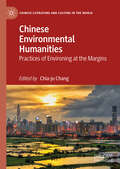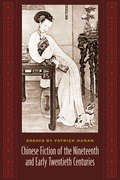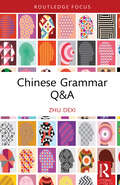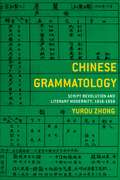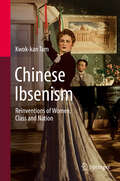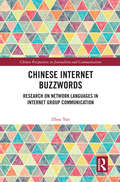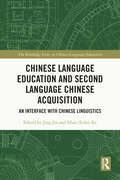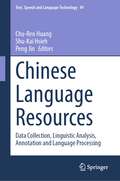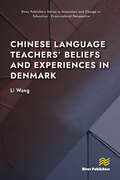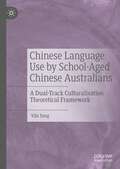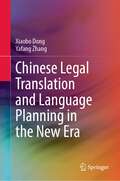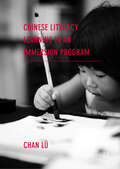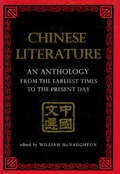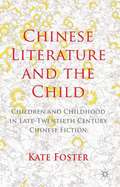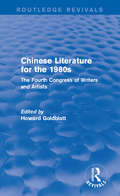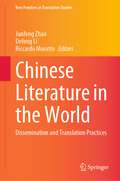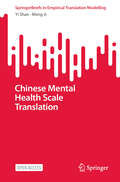- Table View
- List View
Chinese Environmental Humanities: Practices of Environing at the Margins (Chinese Literature and Culture in the World)
by Chia-Ju ChangChinese Environmental Humanities showcases contemporary ecocritical approaches to Chinese culture and aesthetic production as practiced in China itself and beyond. As the first collaborative environmental humanities project of this kind, this book brings together sixteen scholars from a diverse range of disciplines, including literary and cultural studies, philosophy, ecocinema and ecomedia studies, religious studies, minority studies, and animal or multispecies studies. The fourteen chapters are conceptually framed through the lens of the Chinese term huanjing (environment or “encircling the surroundings”), a critical device for imagining the aesthetics and politics of place-making, or “the practice of environing at the margin.” The discourse of environing at the margins facilitates consideration of the modes, aesthetics, ethics, and politics of environmental inclusion and exclusion, providing a lens into the environmental thinking and practices of the world’s most populous society.
Chinese Fiction of the Nineteenth and Early Twentieth Centuries: Essays by Patrick Hanan (Masters of Chinese Studies #Vol. 2)
by Patrick HananIt has often been said that the nineteenth century was a relatively stagnant period for Chinese fiction, but preeminent scholar Patrick Hanan shows that the opposite is true: the finest novels of the nineteenth century show a constant experimentation and evolution. In this collection of detailed and insightful essays, Hanan examines Chinese fiction before and during the period in which Chinese writers first came into contact with western fiction. Hanan explores the uses made of fiction by westerners in China; the adaptation and integration of western methods in Chinese fiction; and the continued vitality of the Chinese fictional tradition. Some western missionaries, for example, wrote religious novels in Chinese, almost always with the aid of native assistants who tended to change aspects of the work to "fit" Chinese taste. Later, such works as Washington Irving's "Rip Van Winkle," Jonathan Swift's "A Voyage to Lilliput," the novels of Jules Verne, and French detective stories were translated into Chinese. These interventions and their effects are explored here for virtually the first time.
Chinese Grammar Q&A (Chinese Linguistics)
by Zhu DexiThis book offers a concise yet powerful analysis of critical Chinese grammatical concepts, adopting an authentic approach that considers the language on its own terms.Presented in a dialogic form, it discusses characteristics such as parts of speech, subjects and objects, as well as head-word and hierarchical analysis, and the Chinese grammatical system. By reviewing the contentious debates within Chinese linguistics since the 1950s—ranging from parts of speech classifications, subject-object relationships, to grammatical analysis methods—the author reveals how imposing Indo-European grammatical concepts onto Chinese language studies has obscured the language's inherent structural features. Through the use of rich examples, the book provides readers with an authentic view of the language to help them understand the unique structure of Chinese grammar.This essential read is ideal for linguists, scholars of linguistics, students of linguistics, and language learners interested in the Chinese language and grammar.
Chinese Grammatology: Script Revolution and Literary Modernity, 1916–1958
by Yurou ZhongToday, Chinese characters are described as a national treasure, the core of the nation’s civilizational identity. Yet for nearly half of the twentieth century, reformers waged war on the Chinese script. They declared it an archaic hindrance to modernization, portraying the ancient system of writing as a roadblock to literacy and therefore science and democracy. Movements spanning the political spectrum proposed abandonment of characters and alphabetization of Chinese writing, although in the end the Communist Party opted for character simplification.Chinese Grammatology traces the origins, transmutations, and containment of this script revolution to provide a groundbreaking account of its formative effects on Chinese literature and culture, and lasting implications for the encounter between the alphabetic and nonalphabet worlds. Yurou Zhong explores the growth of competing Romanization and Latinization movements aligned with the clashing Nationalists and Communists. She finds surprising affinities between alphabetic reform and modern Chinese literary movements and examines the politics of literacy programs and mass education against the backdrop of war and revolution. Zhong places the Chinese script revolution in the global context of a phonocentric dominance that privileges phonetic writing, contending that the eventual retention of characters constituted an anti-ethnocentric, anti-imperial critique that coincided with postwar decolonization movements and predated the emergence of Deconstructionism. By revealing the consequences of one of the biggest linguistic experiments in history, Chinese Grammatology provides an ambitious rethinking of the origins of Chinese literary modernity and the politics of the science of writing.
Chinese Ibsenism: Reinventions of Women, Class and Nation
by Kwok-kan TamThis book is a study of the relation between theatre art and ideology in the Chinese experimentations with new selfhood as a result of Ibsen’s impact. It also explores Ibsenian notions of self, women and gender in China and provides an illuminating study of Chinese theatre as a public sphere in the dissemination of radical ideas. Ibsen is the major source of modern Chinese selfhood which carries notions of personal and social liberation and has exerted great impacts on Chinese revolutions since the beginning of the twentieth century. Ibsen’s idea of the self as an individual has led to various experimentations in theatre, film and fiction to project new notions of selfhood, in particular women’s selfhood, throughout the history of modern China. Even today, China is experimenting with Ibsen’s notions of gender, power, individualism and self.Kwok-kan Tam is Chair Professor of English and Dean of Humanities and Social Science at the Hang Seng University of Hong Kong. He was Head (2012-18) and is currently a member of the International Ibsen Committee, University of Oslo. He is a Foundation Fellow of the Hong Kong Academy of the Humanities. He has held teaching, research and administrative positions in various institutions, including the East-West Center, the Chinese University of Hong Kong and the Open University of Hong Kong. He has published numerous books and articles on Ibsen, Gao Xingjian, modern drama, Chinese film, postcolonial literature, and world Englishes. His recent books include Ibsen, Power and the Self: Postsocialist Experimentations in Stage Performance and Film (2019), The Englishized Subject: Postcolonial Writings in Hong Kong, Singapore and Malaysia (2019), and a co-edited volume Fate and Prognostication in the Chinese Literary Imagination (2019).
Chinese Internet Buzzwords: Research on Network Languages in Internet Group Communication (Chinese Perspectives on Journalism and Communication)
by Zhou YanAs the Internet has reshaped the way we communicate, people’s reading has become more fragmented and attention has been directed to a more concise and general form of language that outlines the most important information. This language of the internet, a language system that concentrates on the content of events and public emotions, has emerged and received wide currency. This monograph is one of the first books to examine the language of the internet in the Chinese context. By analysing content and discourse, the author examines Chinese website buzzwords since 2010. She reveals the mechanisms of generation, the cultural nature and political characteristics of the network language, analyzes the causes of its emergence and popularity, and highlights its social and academic significance. Meanwhile, she argues that research in the area is essentially interdisciplinary, involving not only perspectives from Journalism and Communication Studies, but also Philosophy, Culture, Linguistics and Sociology. Students and scholars of Communication Studies and Journalism, as well as Culture Studies should be greatly interested in this title.
Chinese Interpreting: Strategies and Teaching Methodologies (Palgrave Studies in Translating and Interpreting)
by Riccardo MorattoThis book dives into the world of Chinese interpreting, exploring fundamental challenges and topics such as consecutive and simultaneous interpreting, medical, courtroom and media interpreting, as well as interculturality. The book establishes a strong theoretical foundation, delving into principles and techniques for successful Chinese interpreting, before proceeding to examine note-taking in consecutive interpreting, strategies for effective information organization, and providing valuable insights through practical examples. The authors explore the realm of Chinese simultaneous interpreting, examining techniques for conveying meaning in real-time and addressing the unique challenges of medical interpreting. The book also covers the impact of technology on interpreting, the integration of artificial intelligence, and ethical considerations. With its theoretical foundations, practical examples, and in-depth exploration of various topics, this book serves as an indispensable resource for aspiring interpreters, practitioners seeking to enhance their knowledge, and researchers aiming to investigate the intricate world of Chinese interpreting.
Chinese Language Education and Second Language Chinese Acquisition: An Interface with Chinese Linguistics (The Routledge Series on Chinese Language Education)
by Jing Jin Sihui KeThis edited volume presents the latest scholarly endeavors to synergize Chinese linguistics with Chinese language education and L2 Chinese acquisition, a direction of inquiry that has emerged as a rapidly developing area and attracted both teaching practitioners and linguists’ interests in recent years.The studies presented in the volume approach a diversity of issues, ranging over linguistics-informed Chinese language education in the contexts of Hong Kong, mainland China, and overseas countries; language pedagogies along various linguistic approaches; L2 Chinese development of different linguistic properties; bilingualism and multilingualism among adult and school learners; as well as linguistically grounded Chinese language learning and teaching via digital means. The volume offers to deepen the reader’s understanding of the existing theories on Chinese language education and L2 Chinese acquisition, and the linguistic theories regarding the nature, component modules, and development of the human language faculty. It also offers new pedagogical inspiration, based on cutting-edge empirical research, for Chinese language teaching in different educational settings.Of interest to scholars in the fields of Chinese language teaching and learning, second language acquisition, or applied linguistics, this volume contributes to the emerging field of educational applications of linguistics and presents an overarching framework that bridges a long-lasting division between language teaching practice and linguistic research.
Chinese Language Resources: Data Collection, Linguistic Analysis, Annotation and Language Processing (Text, Speech and Language Technology #49)
by Chu-Ren Huang Shu-Kai Hsieh Peng JinBased on the accumulation of research experience and knowledge over the past 30 years, this volume lays out the research issues posed by the construction of various types of Chinese language resources, how they were resolved, and the implication of the solutions for future Chinese language processing research. This volume covers 30 years of development in Chinese language processing, focusing on the impact of conscientious decisions by some leading research groups. It focuses on constructing language resources, which led to thriving research and development of expertise in Chinese language technology today. Contributions from more than 40 leading scholars from various countries explore how Chinese language resources are used in current pioneering NLP research, the future challenges and their implications for computational and theoretical linguistics.
Chinese Language Teachers’ Beliefs and Experiences in Denmark
by Li WangThis book presents recent advances in foreign language education as well as recent work on Chinese language education and CFL teacher development in international contexts. It also reports the results of three qualitative studies on the experiences and beliefs of teachers of the Chinese language in in Denmark.There are rising concerns over quality issues in both Chinese language education and teacher development in Scandinavian countries and worldwide, broadly due to China’s rapid growth and the increasing worldwide popularity of Chinese. What CFL (Chinese as a Foreign Language) teachers believe in teaching and experience in the intercultural context have proposed new questions and issues. The book addresses issues and topics such as teacher beliefs about Chinese language teaching, factors shaping teacher beliefs, the teaching of Chinese by both native and non-native teachers, Chinese language and culture teaching, intercultural encounters and challenges, etc. It provides both macro- and micro-level insights into the key issues and challenges in the development of Chinese language teachers in Denmark and the Scandinavian region.Taking the perspectives of Chinese language teachers’ beliefs and experiences, this book reveals teachers’ beliefs about their roles, objectives, and ways of teaching at the micro level. It also discusses the macro-level factors that promote or impede the adaptation of native-speaking teachers of Chinese and the development of Chinese-language education in this Nordic country. It will be of interest to teachers, teacher educators, administrators of Chinese as a foreign language, and researchers concerned with foreign language education in an intercultural context.
Chinese Language Use by School-Aged Chinese Australians: A Dual-Track Culturalisation Theoretical Framework
by Yilu YangThis book examines the use of Chinese by school-aged Chinese Australians from a dual-track culturalisation perspective. Drawing upon interviews, participant observations and documentary analysis, the author discusses why and how these children learn and use Chinese in multiple social settings, and how they construct their understanding of language and identities in doing so. The book will appeal to students and scholars in the fields of sociolinguistics, migration studies, sociology of education, language and communication amongst other areas in the social sciences.
Chinese Legal Translation and Language Planning in the New Era
by Xiaobo Dong Yafang ZhangBy making a comprehensive and interdisciplinary analysis on the translation history of both the ancient Chinese legal classics and the modern laws and regulations, this book presents a full picture of development of Chinese legal translation. Legal translation in China has undergone twists and turns in the past and always lacked a systematic and comprehensive theoretical framework. Therefore, guided by the language planning theory, this book intends to build a theoretical framework for study and practices of legal translation in the New Era and provide a feasible path for general readers, students of relevant majors, and professionals interested in Chinese legal culture to get a refreshed understanding legal translation and legal culture promotion.
Chinese Literacy Learning in an Immersion Program
by Chan LüThis book examines one-way foreign language immersion education in the United States. It provides a clear and rich description of a Chinese (Mandarin) immersion program, its curriculum, instructional materials, assessment activities, parental involvement and student outcomes. The author analyses two studies that document the development of the students’ reading skills in English and Chinese, and the progress of their vocabulary knowledge, lexical inference, and reading comprehension in Chinese. In addition, this book contextualizes the program in its eco-system, including its neighbourhood, school, and the school district, and discusses the importance of school leadership, parental involvement, neighbourhood support and language acquisition planning in making an innovative school program successful. Its concluding chapters offer recommendations for program- and classroom-level practices and suggest pathways for future research on biliteracy learning in Chinese one-way immersion programs. This book will appeal in particular to students and scholars of applied linguistics, second language acquisition and language education.
Chinese Literature
by William McnaughtonAlmost three thousand years of Chinese literature have been gathered together in Chinese Literature: An Anthology from the. Earliest Times to the Present Day. The earliest preserved folk songs of the peasantry; the major works of the "Golden Age" of Chinese philosophy; the "prose-songs" and the later skillful poems of the T'ang dynasty ; the short stories and plays; the novels ; andthe poems and stories of men who have made modern China - all these are represented in this anthology, in complete works or in excerpts.
Chinese Literature And The Child
by Kate FosterChinese Literature and the Childis a far-reaching study of images of children in post-Cultural Revolution novels and short stories. Considering works from over twenty writers, including some of China's leading literary stars, this book spans two decades of China's recent and rapid transformation. Tracking ideas of the child in Chinese society across the twentieth century, Kate Foster places fictional children within the story of the nation in a study of tropes and themes which range from images of strength and purity to the murderous and amoral. In this ambitious and revealing study, Foster views China's imagined children in relation to major shifts in Chinese culture and society and through literary theory, and argues convincingly for the significance of the child in fiction in the construction of adult identity in a time of change.
Chinese Literature for the 1980s: The Fourth Congress of Writers and Artists (Routledge Revivals)
by Howard GoldblattEditor Howard Goldblatt explains that while most societies analyse and revere their literary trends in retrospect, post-Liberation China’s literary trends tend to be announced beforehand allowing for critics to judge how close or far from the prescribed norms a piece of art is. In this volume, a collection of speeches and reports from the Fourth Congress of Writers and Artists, well-known Chinese writers (novels, poets, and dramatists alike) debate the future direction of Chinese literature for the 1980s. Originally published in 1982, the book lends a contemporary view into the state of art and literature in China during a critical era of transformation. This title is suitable for students of Literature and East Asian Studies.
Chinese Literature in the World: Dissemination and Translation Practices (New Frontiers in Translation Studies)
by Defeng Li Junfeng Zhao Riccardo MorattoThis book features a collection of articles on comparative literature from a translational perspective, with a special reference to translation of contemporary Chinese literature. Issues of translation, dissemination, and reception of translated literature in the context of world literature are the foci of the book. Given its scope, the book appeals particularly to teachers and students of Chinese literature, translation, and Sinology.
Chinese Mental Health Scale Translation (New Frontiers in Translation Studies)
by Meng Ji Yi ShanThis open access book illustrates the key steps and procedures of developing mental health scales into linguistically and culturally appropriate translations. Through illustrative case studies, we demonstrate that traditional forward and backward translation have significant methodological limitations when applied in mental health scale translation, such as linguistic and cultural inaccessibility and inaccuracy in the clinic. Our book will stimulate more academic debates and further systematic research into the significant, interdisciplinary area of mental health translation, which has been underexplored in Translation Studies.
Chinese Modern: The Heroic and the Quotidian
by Xiaobing TangChinese Modern examines crucial episodes in the creation of Chinese modernity during the turbulent twentieth century. Analyzing a rich array of literary, visual, theatrical, and cinematic texts, Xiaobing Tang portrays the cultural transformation of China from the early 1900s through the founding of the People's Republic, the installation of the socialist realist aesthetic, the collapse of the idea of utopia in the aftermath of the Cultural Revolution, and the gradual cannibalization of the socialist past by consumer culture at the century's end. Throughout, he highlights the dynamic tension between everyday life and the heroic ideal. Tang uncovers crucial clues to modern Chinese literary and cultural practices through readings of Wu Jianren's 1906 novel The Sea of Regret and works by canonical writers Lu Xun, Ding Ling, and Ba Jin. For the midcentury, he broadens his investigation by considering theatrical, cinematic, and visual materials in addition to literary texts. His reading of the 1963 play The Young Generation reveals the anxiety and terror underlying the exhilarating new socialist life portrayed on the stage. This play, enormously influential when it first appeared, illustrates the utopian vision of China's lyrical age and its underlying discontents--both of which are critical for understanding late-twentieth-century China. Tang closes with an examination of post-Cultural Revolution nostalgia for the passion of the lyrical age. Throughout Chinese Modern Tang suggests a historical and imaginative affinity between apparently separate literatures and cultures. He thus illuminates not only Chinese modernity but also the condition of modernity as a whole, particularly in light of the postmodern recognition that the market and commodity culture are both angel and devil. This elegantly written volume will be invaluable to students of China, Asian studies, literary criticism, and cultural studies, as well as to readers who study modernity.
Chinese Multiword Expressions: Theoretical and Practical Perspectives
by Shan WangThis book is the first English monograph to systematically explore Chinese Multiword expressions (MWEs) by applying corpus-driven and corpus-based approaches. It reveals the unique characteristics of Chinese MWEs by examining their core attributes, identification and classification, and knowledge framework. It also assesses, for the first time, the distribution and density of Chinese MWEs in textbooks. By doing so, the book provides important insights into Chinese language learning, with implications for natural language processing, lexicography, and psychology. Moreover, it offers a framework for linguists, language teachers and learners, computer scientists, lexicographers, and psychologists to explore their own areas of interest.
Chinese Narrative Poetry: The Late Han Through T'ang Dynasties
by Dore J. LevyChinese Narrative Poetry brings a new perspective to some of China's best-loved and most influential poems, including Ts'ai Yen's "Poem of Affliction," Po Chu-yi's "Song of Everlasting Sorrow," and Wei Chuang's recently discovered "Song of the Lady of Ch'in." Composed in the shih form during the Late Han, Six Dynasties, and T'ang periods, these poems stand out as masterworks of narrative art. Yet paradoxically, their narrative qualities have been little recognized or explored in either traditional Chinese or modern Western scholarship. The reason for this neglect is that Western literary traditions acknowledge their origins in epic poetry and thus take narrative for granted, but the Chinese tradition is fundametally based on lyric and does not admit of a separate category for narrative poetry.Drawing on both classical Chinese critical works and the most recent Western contributions to the theory of narrative, Levy shows how narrative elements developed out of the lyrical conventions of shih. In doing so, she accomplishes a double purpose, guiding the modern reader to an understanding of the nature of narrative in Chinese poetry and shedding light on the ways in which Chinese poets adapted the devises of lyric to the needs of a completely different expressive mode.Students of Chinese literature will welcome this pathbreaking study, but Chinese Narrative Poetry will interest other scholars as well because it addresses questions of crucial importance for literary theory and comparative literature, particularly the central issue of the applicability of Western critical concepts to non-Western literature and culture.
Chinese Narratologies
by Xiuyan FuThis book provides a more rational and systematic explanation for the origin and evolution of the Chinese narrative tradition, based on studies of Chinese literary classics, local culture and items such as bronze wares and porcelain vessels with “portrayed stories.” By doing so, it uncovers forgotten interconnections and reestablishes obscured or unacknowledged lines of descent. Furthermore, it makes an initial study of acoustic narrative. Going beyond the field of literature, it employs tools and materials from diverse fields such as anthropology, religious studies, mythology, linguistics, semiotics, folklore and local culture. The book also offers an archeological inquiry into the knowledge found in various narrative texts, objects with “portrayed stories” and perceptions with “relevant plots.” Providing a wealth of insights, inspiring investigative methods and practical tools that can be applied in narrative studies, the book is an essential resource for researchers and students in the fields of comparative literature, narratology and ancient Chinese literature.
Chinese Narratology I: Heaven and Human (China Perspectives)
by Yang YiAs the first volume of a two-volume set on Chinese narratology, this title introduces the cultural fundamentals that nurture Chinese literary works and investigates the structure and time of Chinese narrative. In the introductory chapter, the author examines the intrinsic association between Chinese writers’ narrative techniques and China’s cultural background by putting forward a Principle of Duixing to facilitate the study of those techniques and three steps to revisit Chinese narrative. Based on Western narrative theories and a close reading of outstanding Chinese literary classics, the volume focuses on structure and time in Chinese narrative. The first part on structure (jiegou) identifies five essential themes to analyze the dual dynamic structure of Chinese narrative. In terms of aspects of time, the author demonstrates how the holistic view of time and space in the Chinese tradition influences the chronological framework of narratives and shapes the outset of a story. The book is a must-read for scholars and students interested in narrative theory, Chinese culture and literature, and the dialogue between Chinese and Western narratological studies.
Chinese Narratology II: Ancient and Modern (China Perspectives)
by Yang YiAs the second volume of a two-volume set on Chinese narratology, this title investigates the quintessential characteristics of the Chinese narrative style, with a focus on image and perspective.The first chapter introduces two opposing concepts of perspective: “focalization” and “blind spot,” to connect “perspective” with traditional aesthetics, highlighting the mutual relation of the nonexistent and the existent. The author believes that both the narrator and perspective are central to the narrative forms and strategies adopted by Chinese writers and that study of the narrator and perspective is integral to understanding the cultural, aesthetic, and philosophical connotations of the narrative text and the spiritual world of the author. Drawing on perceptual phenomenology, the chapter on image broadens the extant knowledge of “image” and points out that image narration is unique to Chinese narratology and central to Chinese aesthetics. The final chapter illustrating the achievements of influential critics of classical Chinese novels, proving that these critics have contributed to the canonization of the genuine masterpieces of Chinese narrative literature.The book is a must-read for scholars and students interested in narrative theory, Chinese culture and literature, and dialogue between Chinese and Western narratological studies.
Chinese News Discourse: From Perspectives of Communication, Linguistics and Pedagogy (Routledge Studies in Chinese Discourse Analysis)
by Nancy Xiuzhi Liu , Candace Veecock and Shixin Ivy ZhangAs a country in transition, Chinese news discourse has quite distinctive characteristics, and more so given the power of state media in society. With China’s engagement in world affairs and its massive Belt and Road Initiative (BRI) now in place, Western media coverage of China has dramatically increased. Against this backdrop, news dissemination and discourse demonstrate a need for academia to give perspectives with interdisciplinary approaches. Chinese News Discourse presents original research from academics in China and the West, showing theoretical, methodological and practical dimensions between news media and discourse. The book focuses on Chinese news discourse by examining what new modern features it demonstrates in contrast and comparison to news discourses in other countries in the coverage of such hot topics as the BRI or the 70th Anniversary of the Founding of the People’s Republic of China, just to name a few. This book is a useful resource for scholars and students of discourse, language, media and communication studies, as well as translation studies.
